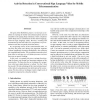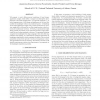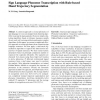104 search results - page 5 / 21 » Recognizing Sign Language from Brain Imaging |
DAGM
2005
Springer
14 years 4 months ago
2005
Springer
In this paper, we employ a zero-order local deformation model to model the visual variability of video streams of American sign language (ASL) words. We discuss two possible ways o...
FGR
2008
IEEE
14 years 5 months ago
2008
IEEE
The goal of the MobileASL project is to increase accessibility by making the mobile telecommunications network available to the signing Deaf community. Video cell phones enable De...
ICIP
2010
IEEE
13 years 8 months ago
2010
IEEE
We propose a novel affine-invariant modeling of hand shapeappearance images, which offers a compact and descriptive representation of the hand configurations. Our approach combine...
ICPR
2006
IEEE
14 years 12 months ago
2006
IEEE
We present a novel training method for recognizing traffic sign symbols undergoing image degradations. In order to cope with the degradations, it is desirable to use similarly deg...
VLSISP
2010
13 years 5 months ago
2010
A common approach to extract phonemes of sign language is to use an unsupervised clustering algorithm to group the sign segments. However, simple clustering algorithms based on dis...



